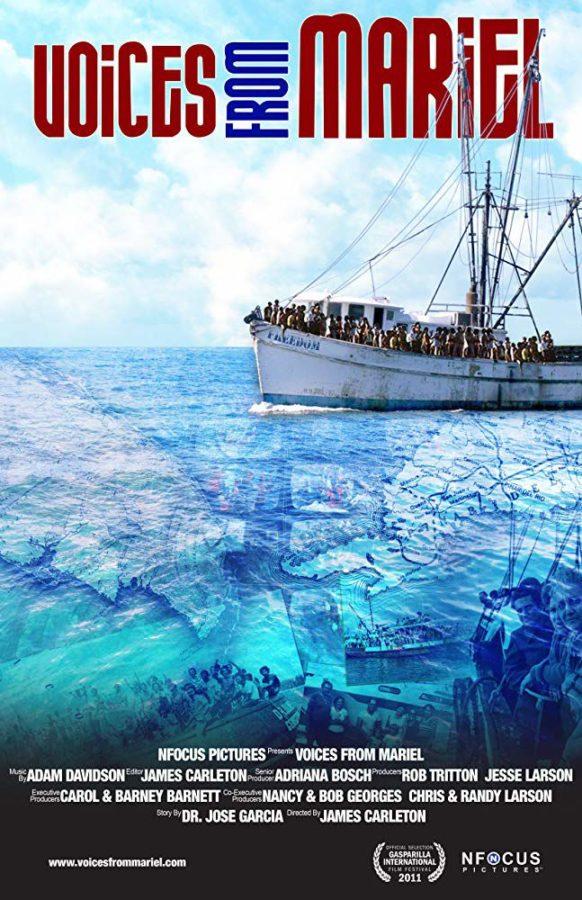Latinx film tells story of Mariel boatlift
Parks Library screened “Voices from Mariel” Thursday night. The film focused on the story of the 125,000 Marielitos who fled Cuba in 1980.
October 3, 2019
After the Cuban Revolution in 1950, Cubans were forced to live under communist rule and many lost property, but even more lost rights. One of the ways Cubans sought to escape this life was through the Mariel boatlift.
As part of Latinx Heritage Month, Parks Library is presenting four films that pertain to Latinx experience in the United States. The third film, “Voices from Mariel,” was shown on Thursday to a room of 10 people.
The film followed José Garcia, an associate professor of Hispanic literature and Latin American studies at Florida Southern College, as he traveled around Cuba in search of those who stayed behind after the Mariel boatlift in 1980 and talked with those who left for America.
The Mariel boatlift was a mass emigration of Cubans who traveled from Cuba’s Mariel Harbor to the United States between April 15 and Oct. 31, 1980. In the end, over 125,000 Marielitos emigrated from Cuba to Florida through the boatlift. The term “Marielito” is used to refer to these refugees in both Spanish and English.
Several attempts by Cubans to seek asylum at the embassies of South American countries set the stage for the events of the spring of 1980. A group of Cubans attempted to enter the Peruvian embassy in the last week of March, and on April 1 a group of six driving a city bus was successful in doing so and a Cuban guard was killed by a ricocheting bullet.
The Peruvians announced they would not hand those seeking asylum over to Cuban police. Following that announcement, about 50 Cubans entered the embassy grounds. By nightfall on April 5, that number had grown to 2,000, including many children and a few former political prisoners.
This trickle of people soon turned into a flood — by April 6 the crowd had reached 10,000 — and as sanitary conditions on the embassy grounds deteriorated, Cuban authorities prevented further access.
One person in the film described the horrible conditions within the embassy, which was no bigger than a football field. He said they had to use a hallway as a latrine and it smelled like “death.”
According to the film, on April 20 Fidel Castro, former prime minister of Cuba, said anyone who wanted to leave could, because the country did not want them. He called them “escoria,” which means filth, and encouraged those still loyal to Cuba to attack those who wanted to leave. Loyalists threw rocks and beat others with baseball bats as they fled to the embassy.
During this speech, Castro said the port of Mariel would be opened to anyone wishing to leave Cuba, as long as they had someone to pick them up. Soon after, many Cuban-Americans began making arrangements to pick up refugees in Mariel harbor.
Those wishing to leave were sent to El Mosquito, which one man in the film described as “an animal pen by the sea.” While at El Mosquito, those wishing to leave were packed in with individuals the Cuban government wished to get rid of, such as ex-convicts, criminals, homosexuals, prostitutes and the mentally ill.
When the boats started to arrive in the port of Mariel they came in all shapes and sizes. There was every kind of boat, ranging from shrimp boats to yachts, and Cuban officials started to fill them. Many of the boats were overcrowded, with upwards of 300 individuals per boat.
Once the emigrating Marielitos were packed on the boats, they embarked on the 90-mile journey to Key West, which was extremely dangerous. There were high waves washing over the boats and many boats ran out of gas and had to be towed. One woman in the film talked about how an engine overheated and shot petroleum into the air, which started to burn her and others on their boat.
Once the Marielitos reached Florida, they were processed at camps set up in the greater Miami area, generally at decommissioned missile defense sites. Other sites were established at the Orange Bowl and various churches throughout the area. Once initially processed and documented, the refugees were reunited with relatives already living in the United States or sent to larger processing facilities.
Crowded conditions in South Florida immigration processing centers forced U.S. federal agencies to move many of the Marielitos to other centers in Fort Indiantown Gap, Pennsylvania; Fort McCoy, Wisconsin; Camp Santiago, Puerto Rico, and Fort Chaffee, Arkansas. From here the Marielitos waited either to be cleared and released or waited for their family to come claim them.
At the end of the film, those who emigrated talked about how, even though they left Cuba and are happy they did, they still miss Cuba and it will always be part of their heritage.
After the film, Lucia Suarez, associate professor of world languages and cultures, facilitated a discussion among attendees.
Suarez talked about how this was only one of the five major Cuban exoduses as citizens tried to escape communism seeking a better life. She also asked attendees to consider comparing the Mariel exodus to the migration of immigrants from South America today and how it is both similar and different.
The next film screening in the series will take place at 6 p.m. Oct. 10 in Parks Library room 198.







